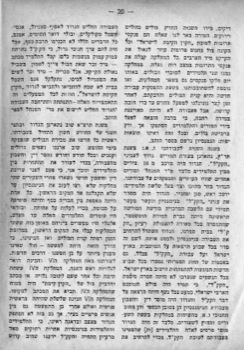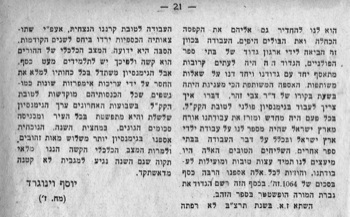I. Our Activities for the Keren HaKayemet
By: Yosef Vinograd (7
th grade)
I was in 4
th grade when the teacher entered the classroom and a pile of small notebooks in his hands. We were curious about them. In his other hand, the teacher held blue and green stamps. He then explained to us that the notebooks were for the purpose of contributions to
HaKeren HaKayemet LeIsrael [KK”L] and those who buy a stamp for 5 coins helps redeem the lands from the Arabs. We reacted in good spirits to the challenge. Two classmates were chosen as “sellers” of the stamps. That same day such notebooks were given to the other classes as well. During recess we were active in buying the stamps and sticking them to our notebooks. Within a short time we got used to this task and regarded it as a holy obligation. Most of the selling and collection was done by the teachers and the pupils were occupied mainly in the buying of the stamps.
The results were impressive as our high school was registered in the “Golden Book”.
In the second year, 1930, a KK”L “brigade” was organized. It consisted of 16 representatives from among the pupils in addition to the principal and some teachers supervising our activity. The “brigade” elected 3 of its members to the post of chairman, deputy and a secretary. The council kept in touch with the main office in Warsaw.
The teacher Mrs. Hofshteter was totally devoted to the task of spreading the ideas of the KK”L in our school. The “brigade” made efforts to do more and more. It arranged for weekly lectures on the settlements in
Eretz Israel and the projects carried out by the KK”L. In the Literary circle weekly news were brought to the participants about the development of the population in the Land.
The slogan of the KK”L, and the topic of
Eretz Israel were marked in all parties that took place in school. In most parties the “brigade” gave a report on its activities – financial and educational; that is: discussions in the class during lessons and otherwise. Pupils who excelled in their activity were given prizes. The “brigade” announced the collection of the silvery wrapping papers of candies, worn out electrical bulbs and stamps. These collected items were not such a rich source of money but they had a great educational value. The KK”L became engraved deep in the souls of the pupil. A pupil got a letter – he immediately remembered to keep the stamp for the redemption of the land. In all parties that took place in school the slogan of the KK”L, and the topic of
Eretz Israel were marked. In most parties the “brigade” gave a report on its activities – financial and educational; that is: discussions in the class during lessons and otherwise. Pupils who excelled in their activity were given prizes. The “brigade” announced the collection of the silvery wrapping papers of candies, worn out electrical bulbs and stamps. These collected items were not such a rich source of money but they had a great educational value. The KK”L became engraved deep in the souls of the pupil. A pupil got a letter – he immediately remembered to keep the stamp for the redemption of the land. He ate a candy and immediately put the silvery-wrapping in his pocket. An electric bulb was burned down, he did not forget to put it aside and bring it to school to the “brigade”. The brigade registered the principal of the school in the “Golden Book” of KK”L.
In 1931, the brigade was reorganized, it renewed the selling of stamps, organized big and small parties and a monthly report was submitted of activities to encourage competition. I remember one time before the reports were submitted, two classes remained after school – each collecting more and more money to surpass the other in order to win “first place”. They would have stayed until evening if not for an intervention to offer a compromise: both earned “first place”.
Buying of stamps weakened and we looked for new ways. The 6
th graders prepared New Year cards. The 4
th graders prepared a box to insert in a postcard or a letter with a stamp stuck to it. The 4
th graders delivered the cards by themselves.
We were sad to discover that the pupils of other high schools were detached from the idea of “revival” and from the activities of KK”L. We wished to get them interested in the “blue box” and stamps. This activity resulted in the organization of a “brigade” of the Polish schools. That brigade would have shared meetings to discuss common issues. The most interesting meeting was when Dr. Tzvi Zohar visited us. We discussed how to work in a Polish high school for the KK”L. Every now and them our activity was encouraged and revived by a visit of a guest from
Eretz Israel. He would tell us of the activities carried by the pupils of
Eretz Israel and in other school. Thanks to their good advice we collected a large sum of money – 1064
zehuvim (gold coins). That enabled us to register Mrs. Hofshteter in the “Golden Book”
This year, 1932, our activity has not weakened even though the collection was less than in previous years. This is due to the bad economic situation of the parents. Still efforts are being done through parties dedicated to the KK”L. The last few weeks we organized a chain-collection in the whole town and we collected more than 300
zehuvim.
We are hopeful to further collect not less than last year.
Yosef Vinograd. 7
th grade.



